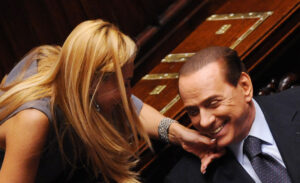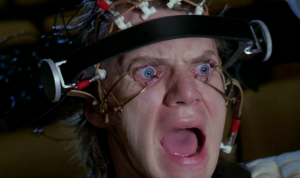“Creative” activities for little children tend to fall into two categories: unconstrained mess-making, and strict conformity to a pre-prepared template. The former encompasses the kind of smear and splatter “art” adoring parents pin to the fridge, while the latter looks more like colouring books, or — alternatively — the Toucan Box type “craft kits” beloved by middle-class families.
These two approaches to creativity for kids, the splatter and the craft kit, encapsulate two far broader lessons we deliver to children on how to live. On the one hand, unbounded self-expression coupled with absolute aesthetic relativism, in which we reject any imaginable constraint on a kind of “creativity” we imagine to come only from within ourselves. On the other, a rigid obedience to externally-imposed rules. And when I learned, earlier this week, that some secondary school children are now identifying as non-human creatures — or, in one case, as a cape-wearing moon — it left me wondering: do such absurdities apply the former lesson, rejecting every rule in the name of self-expression? Or are such youth in fact colouring inside the lines their teachers — which is to say us, the adults — have provided?
Schoolchildren, we learn, are now identifying as dinosaurs, horses, cats, and even planetary bodies. One pupil at a secondary school in Wales reported that a fellow pupil “feels very discriminated against if you do not refer to them as ‘catself’”. She added: “When they answer questions, they meow rather than answer a question in English. And the teachers are not allowed to get annoyed about this because it’s seen as discriminating.”
When my own daughter was a toddler, an art-world friend and I used to send one another pictures of our kids’ splatter paintings, with solemn commentary in the style of a contemporary gallery. Such affectionate mum-jokes aside, though, it would be extremely bad form to greet your pre-schooler’s colourful smears with substantive artistic critique rather than unalloyed delight, simply as joyful self-expression.
But it’s one thing embracing a three-year-old’s poster-paint splodges with judgement-free rapture. It’s another altogether when secondary-school teachers embrace (or, perhaps in many cases, have imposed on them) an equivalent refusal to judge even the most unconstrained self-expression. Within this stance of unconditional acceptance, the teachers in question are left completely unable to impose boundaries, even when limiting their pupils’ self-expression would, in fact, be a basic precondition for conducting a functional, meow-free lesson.
But while the contrasting approach to creativity — lines to colour inside, or a pre-prepared kit for assembly, for example — seems to offer more structure, in practice it’s less different than you might imagine. Whether literally or metaphorically, the “craft kit” approach represents the other extreme to the splatter painting: a total or near-total relinquishing of skill, judgement, and agency, in favour of pre-prepared templates.
And we see this applied, too, in young people’s lives. Some parents are now heavily involved in their offspring’s university life, and others have even gone into their child’s place of work to help them confront an angry customer, or phoned their boss to ask for a pay rise. Adults are also pre-defining the forms that supposedly radical self-expression takes, and then inviting young people to discover their “authentic selves” by adopting such an identity wholesale: a “craft kit” version of selfhood, as it were, requiring only simple instructions and little in the way of accomplishment. This agency-free, pre-assembled approach to living is now so widely accepted that it commands a whole month-long summer celebration, complete with a pocketbook’s worth of off-the-peg selves from which to choose.
But what, in reality, does either approach offer as a set of moral precepts on how to live? Both work well enough, provided the locus of authority is elsewhere: that is, if you have an admiring mummy to coo at your splatter painting, or a teacher on hand with a kit or print-out for you to complete. But they leave something to be desired at the point where individual judgement and agency is required — which is to say, in theory at least, for the whole of life after childhood.
It’s far rarer to find artistic endeavours offered to children that emphasise imitation, practice, and mastery of a technical skill — for example drawing freehand rather than colouring in. This is unsurprising, in a way: even assuming you possess the skill in question, helping a child make something nice using a method that’s difficult to master is much more time-consuming than praising them for making a mess, or else giving them a kit to do while you catch up on emails.
But the trouble with such approaches to “creativity” is precisely this: they swerve the acquisition of skill. And this means, in the end, swerving the acquisition of agency. We used to understand this, and treat artistic education as the inculcation of skill and judgement through practice. In the studios of Renaissance sculptors, for example, would-be “creatives” could spend years imitating existing works, and mastering technical skill, artistic register, and the larger aesthetic framework, before they were allowed anywhere near a composition of their own. The resulting skill, in the hands of even an average sculptor, could produce good work; allied with an exceptional talent such as Michelangelo’s, the result was masterpieces still world-famous today.
We might say: was Michelangelo not also expressing himself? Well, yes; but for all that his creations are exceptional in their vividness and exquisite execution, they also exist within a tradition of craftsmanship, as well as a visual register and shared religious and mythological framework. And creativity within such a demanding frame implies submission to what the philosopher-engineer Matthew Crawford calls the “affordances” of your chosen material and métier: not just your patiently-acquired skill, but also what stone can be persuaded to do, plus more broadly the topics and visual language that will make the result meaningful to others.
In place of this difficult-to-acquire matrix of skill and meaning, we’ve embraced the idea that “creativity” is a spontaneous property of individuals, drawn solely from within an individual without much need for training, practice, or imitation. So much so, in fact, that we’re running full-tilt into a new aesthetic age, that hands the aggregate treasure-trove of historic human visual and linguistic conventions wholesale to machines, treating it simply as a means of “training” programmes such as ChatGPT and Midjourney so that they may “create” new configurations of that cultural legacy on our behalf.
In doing so, we’ve sidelined that domain’s critical role as an enabler of creativity: providing the meanings to create with, and the skills to realise a vision. And again, we should not find it strange how easily this has been accepted, given that for decades now we’ve been treating the whole domain of skill, practice, and shared meaning as incidental to “creativity”.
There are signs that this poverty of skill-based judgement has percolated upwards, into adults. At the most literal level, adult colouring books are wildly popular as a way of relaxing, a trend that first hit the headlines in 2015. I don’t think it’s a coincidence that this is also the year the American Dialect Society nominated, as most creative new coinage, the transformation of “adult” into a verb meaning “behave like a grownup” — or that the same year, too, the overall American Dialect Society winner for innovative dialect was the “nonbinary” singular “they”.
In other words, in 2015 adults embraced, en masse, a form of artistic endeavour that surrenders overall control to an outside force. The same year, self-created identities became so mainstream as to begin reshaping language. And that same year, adults began expressing, also en masse, a generalised ambivalent distance from their own capacity (or willingness) to behave as adults.
Custom identities, adult colouring books and semi-ironic clinging to childhood have not disappeared since 2015. You can even buy (possibly ironic, possibly not) “I Adulted!” reward stickers on Amazon.But being an adult implies having the skills and knowledge to take independent action: in other words, knowing how to make a Pietà, rather than colouring inside the lines or making a mess.
And what exactly are you to do, as a child, when the adults around you offer no opportunity to develop any skills or moral frameworks, refuse to acknowledge any objective moral or aesthetic standards? Under those circumstances, you will have grown up thinking the skills, norms and shared meanings that form the basis of independent creativity or moral judgement are so irrelevant as to be ceded wholesale to imitation machines.
Then you get to the age of supposed autonomy, and find yourself without either a loving authority figure who will tell you your splatter art is wonderful, or even an authority to give you some lines to colour inside. We shouldn’t be surprised if many such adults feel nostalgia for the innocent age before anyone expected them to like being free.
If I have a measure of hope, it rests with the kids now riotously trolling this limitless-yet-rigid modern orthodoxy of value-free self-expression, by identifying as planets or dinosaurs and forcing their teachers to play along. If such absurdist stunts have little to offer on the artistic front, they nonetheless demonstrate an enduring truth. Human creativity will always meet and exceed its boundaries, even when it’s constrained only by the pretence that we can live without boundaries.
Disclaimer
Some of the posts we share are controversial and we do not necessarily agree with them in the whole extend. Sometimes we agree with the content or part of it but we do not agree with the narration or language. Nevertheless we find them somehow interesting, valuable and/or informative or we share them, because we strongly believe in freedom of speech, free press and journalism. We strongly encourage you to have a critical approach to all the content, do your own research and analysis to build your own opinion.
We would be glad to have your feedback.
Source: UnHerd Read the original article here: https://unherd.com/





